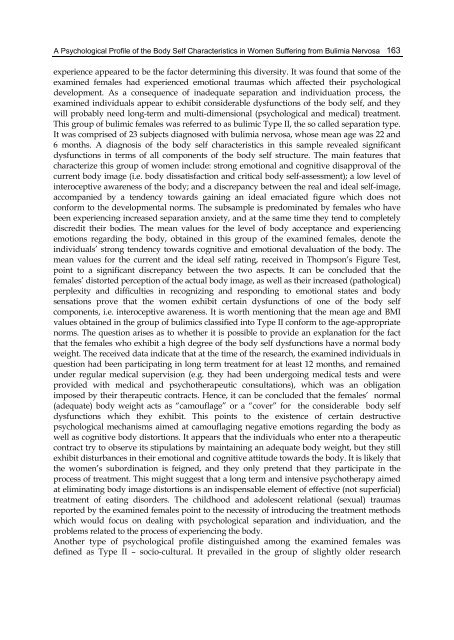new insights into the prevention and treatment of bulimia nervosa
new insights into the prevention and treatment of bulimia nervosa
new insights into the prevention and treatment of bulimia nervosa
You also want an ePaper? Increase the reach of your titles
YUMPU automatically turns print PDFs into web optimized ePapers that Google loves.
A Psychological Pr<strong>of</strong>ile <strong>of</strong> <strong>the</strong> Body Self Characteristics in Women Suffering from Bulimia Nervosa<br />
experience appeared to be <strong>the</strong> factor determining this diversity. It was found that some <strong>of</strong> <strong>the</strong><br />
examined females had experienced emotional traumas which affected <strong>the</strong>ir psychological<br />
development. As a consequence <strong>of</strong> inadequate separation <strong>and</strong> individuation process, <strong>the</strong><br />
examined individuals appear to exhibit considerable dysfunctions <strong>of</strong> <strong>the</strong> body self, <strong>and</strong> <strong>the</strong>y<br />
will probably need long-term <strong>and</strong> multi-dimensional (psychological <strong>and</strong> medical) <strong>treatment</strong>.<br />
This group <strong>of</strong> bulimic females was referred to as bulimic Type II, <strong>the</strong> so called separation type.<br />
It was comprised <strong>of</strong> 23 subjects diagnosed with <strong>bulimia</strong> <strong>nervosa</strong>, whose mean age was 22 <strong>and</strong><br />
6 months. A diagnosis <strong>of</strong> <strong>the</strong> body self characteristics in this sample revealed significant<br />
dysfunctions in terms <strong>of</strong> all components <strong>of</strong> <strong>the</strong> body self structure. The main features that<br />
characterize this group <strong>of</strong> women include: strong emotional <strong>and</strong> cognitive disapproval <strong>of</strong> <strong>the</strong><br />
current body image (i.e. body dissatisfaction <strong>and</strong> critical body self-assessment); a low level <strong>of</strong><br />
interoceptive awareness <strong>of</strong> <strong>the</strong> body; <strong>and</strong> a discrepancy between <strong>the</strong> real <strong>and</strong> ideal self-image,<br />
accompanied by a tendency towards gaining an ideal emaciated figure which does not<br />
conform to <strong>the</strong> developmental norms. The subsample is predominated by females who have<br />
been experiencing increased separation anxiety, <strong>and</strong> at <strong>the</strong> same time <strong>the</strong>y tend to completely<br />
discredit <strong>the</strong>ir bodies. The mean values for <strong>the</strong> level <strong>of</strong> body acceptance <strong>and</strong> experiencing<br />
emotions regarding <strong>the</strong> body, obtained in this group <strong>of</strong> <strong>the</strong> examined females, denote <strong>the</strong><br />
individuals’ strong tendency towards cognitive <strong>and</strong> emotional devaluation <strong>of</strong> <strong>the</strong> body. The<br />
mean values for <strong>the</strong> current <strong>and</strong> <strong>the</strong> ideal self rating, received in Thompson’s Figure Test,<br />
point to a significant discrepancy between <strong>the</strong> two aspects. It can be concluded that <strong>the</strong><br />
females’ distorted perception <strong>of</strong> <strong>the</strong> actual body image, as well as <strong>the</strong>ir increased (pathological)<br />
perplexity <strong>and</strong> difficulties in recognizing <strong>and</strong> responding to emotional states <strong>and</strong> body<br />
sensations prove that <strong>the</strong> women exhibit certain dysfunctions <strong>of</strong> one <strong>of</strong> <strong>the</strong> body self<br />
components, i.e. interoceptive awareness. It is worth mentioning that <strong>the</strong> mean age <strong>and</strong> BMI<br />
values obtained in <strong>the</strong> group <strong>of</strong> bulimics classified <strong>into</strong> Type II conform to <strong>the</strong> age-appropriate<br />
norms. The question arises as to whe<strong>the</strong>r it is possible to provide an explanation for <strong>the</strong> fact<br />
that <strong>the</strong> females who exhibit a high degree <strong>of</strong> <strong>the</strong> body self dysfunctions have a normal body<br />
weight. The received data indicate that at <strong>the</strong> time <strong>of</strong> <strong>the</strong> research, <strong>the</strong> examined individuals in<br />
question had been participating in long term <strong>treatment</strong> for at least 12 months, <strong>and</strong> remained<br />
under regular medical supervision (e.g. <strong>the</strong>y had been undergoing medical tests <strong>and</strong> were<br />
provided with medical <strong>and</strong> psycho<strong>the</strong>rapeutic consultations), which was an obligation<br />
imposed by <strong>the</strong>ir <strong>the</strong>rapeutic contracts. Hence, it can be concluded that <strong>the</strong> females’ normal<br />
(adequate) body weight acts as “camouflage” or a “cover” for <strong>the</strong> considerable body self<br />
dysfunctions which <strong>the</strong>y exhibit. This points to <strong>the</strong> existence <strong>of</strong> certain destructive<br />
psychological mechanisms aimed at camouflaging negative emotions regarding <strong>the</strong> body as<br />
well as cognitive body distortions. It appears that <strong>the</strong> individuals who enter nto a <strong>the</strong>rapeutic<br />
contract try to observe its stipulations by maintaining an adequate body weight, but <strong>the</strong>y still<br />
exhibit disturbances in <strong>the</strong>ir emotional <strong>and</strong> cognitive attitude towards <strong>the</strong> body. It is likely that<br />
<strong>the</strong> women’s subordination is feigned, <strong>and</strong> <strong>the</strong>y only pretend that <strong>the</strong>y participate in <strong>the</strong><br />
process <strong>of</strong> <strong>treatment</strong>. This might suggest that a long term <strong>and</strong> intensive psycho<strong>the</strong>rapy aimed<br />
at eliminating body image distortions is an indispensable element <strong>of</strong> effective (not superficial)<br />
<strong>treatment</strong> <strong>of</strong> eating disorders. The childhood <strong>and</strong> adolescent relational (sexual) traumas<br />
reported by <strong>the</strong> examined females point to <strong>the</strong> necessity <strong>of</strong> introducing <strong>the</strong> <strong>treatment</strong> methods<br />
which would focus on dealing with psychological separation <strong>and</strong> individuation, <strong>and</strong> <strong>the</strong><br />
problems related to <strong>the</strong> process <strong>of</strong> experiencing <strong>the</strong> body.<br />
Ano<strong>the</strong>r type <strong>of</strong> psychological pr<strong>of</strong>ile distinguished among <strong>the</strong> examined females was<br />
defined as Type II – socio-cultural. It prevailed in <strong>the</strong> group <strong>of</strong> slightly older research<br />
163














![focuspdca.ppt [Compatibility Mode]](https://img.yumpu.com/22859457/1/190x146/focuspdcappt-compatibility-mode.jpg?quality=85)


